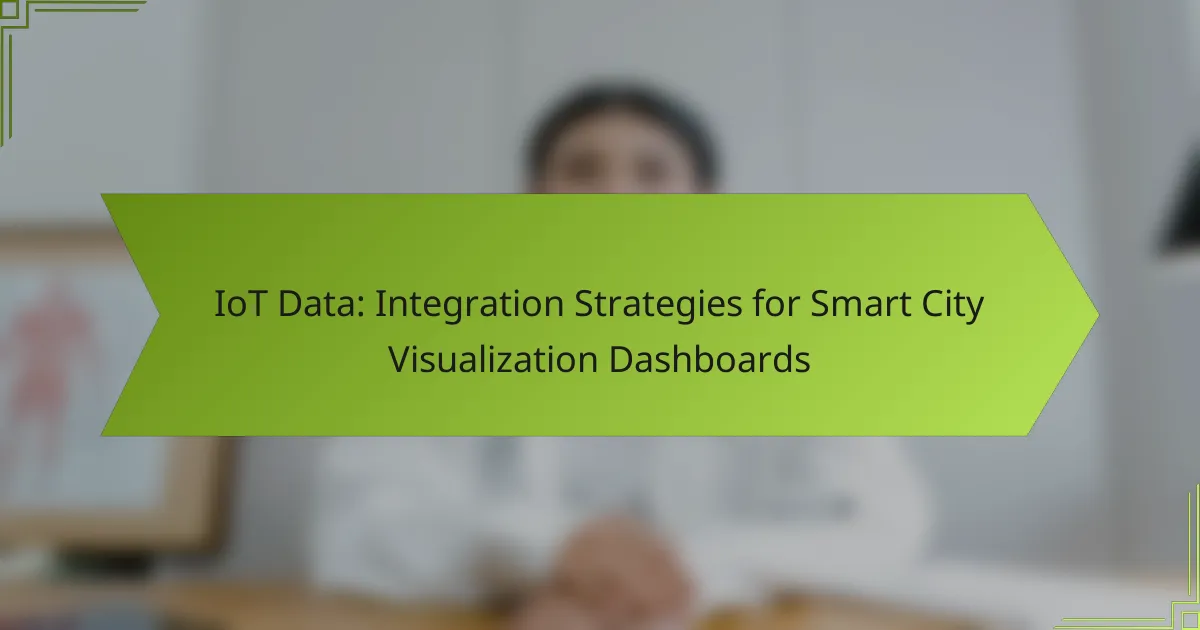Integrating IoT data into smart city visualization dashboards is essential for enhancing urban management and decision-making. By focusing on real-time data processing and efficient aggregation, municipalities can create user-friendly interfaces that provide valuable insights into city operations. Advanced platforms play a crucial role in collecting and visualizing this data, enabling cities to respond effectively to the needs of their residents.
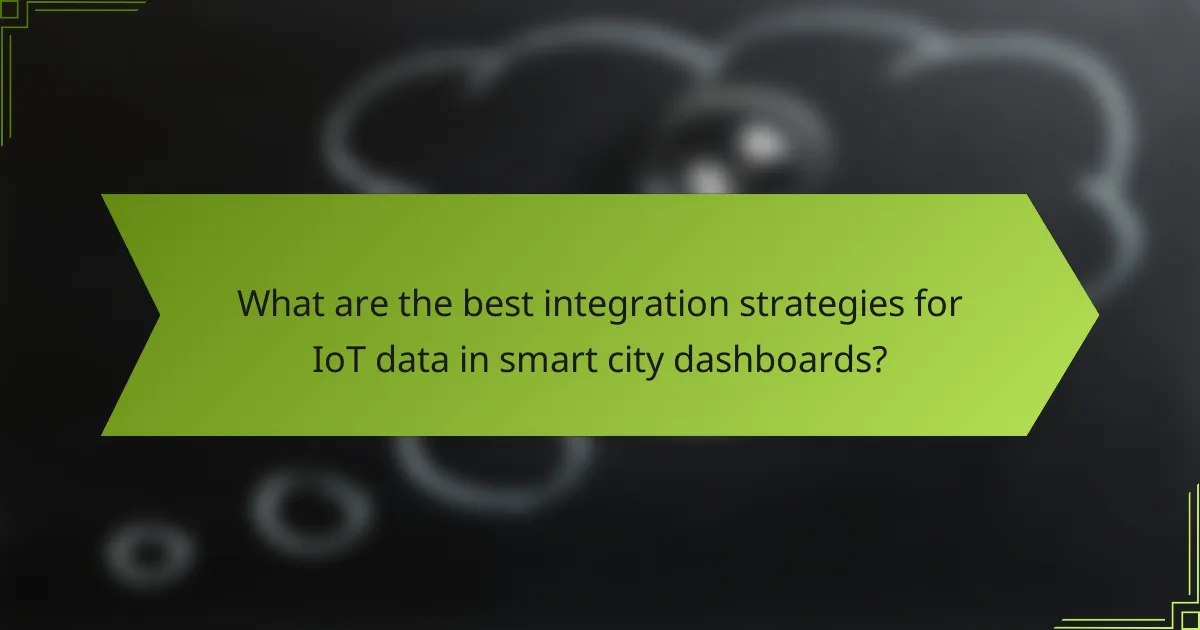
What are the best integration strategies for IoT data in smart city dashboards?
The best integration strategies for IoT data in smart city dashboards focus on real-time data processing, efficient aggregation, and seamless connectivity. Implementing these strategies ensures that cities can visualize and respond to data effectively, enhancing decision-making and operational efficiency.
Real-time data streaming
Real-time data streaming allows cities to process and visualize IoT data as it is generated. This approach is crucial for applications like traffic management and emergency response, where timely information can significantly impact outcomes. Utilizing technologies like Apache Kafka or MQTT can facilitate efficient data flow from various IoT devices.
When implementing real-time streaming, consider the network infrastructure and bandwidth requirements. A robust network is essential to handle the high volume of data generated by smart city sensors, which can number in the thousands.
Data aggregation platforms
Data aggregation platforms consolidate data from multiple sources, providing a unified view for analysis and visualization. These platforms can handle diverse data types, including structured and unstructured data, making them ideal for smart city applications. Solutions like Microsoft Azure IoT Hub or AWS IoT Core can serve as effective aggregation tools.
When selecting a data aggregation platform, evaluate its scalability and compatibility with existing systems. Ensure it can accommodate future growth in IoT devices and data volume, which is likely to increase as smart city initiatives expand.
API integration methods
API integration methods enable different systems and applications to communicate and share data seamlessly. By using RESTful APIs or GraphQL, cities can connect various IoT devices and data sources to their dashboards, ensuring real-time updates and consistent data flow. This integration is vital for creating interactive and responsive visualizations.
To maximize the effectiveness of API integration, prioritize security and data privacy. Implement authentication measures and ensure compliance with local regulations, such as GDPR in Europe, to protect citizen data while facilitating open data initiatives.
Edge computing solutions
Edge computing solutions process data closer to the source, reducing latency and bandwidth usage. This strategy is particularly beneficial for applications requiring immediate responses, such as smart traffic lights or public safety systems. By deploying edge devices, cities can analyze data locally before sending only relevant information to central servers.
When considering edge computing, assess the capabilities of edge devices and their ability to handle specific tasks. Balancing local processing with cloud resources can optimize performance and ensure that critical data is available in real-time without overwhelming central systems.
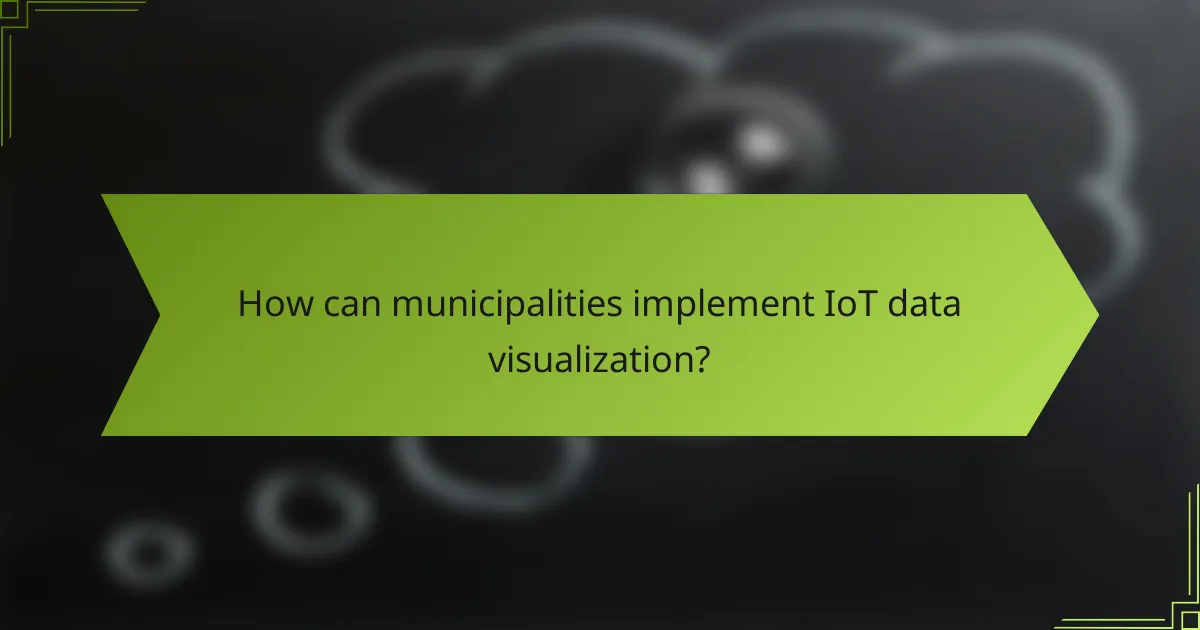
How can municipalities implement IoT data visualization?
Municipalities can implement IoT data visualization by adopting strategies that integrate data from various sources into user-friendly dashboards. This approach enhances decision-making and improves urban management by providing real-time insights into city operations.
Utilizing open-source software
Open-source software offers municipalities a cost-effective way to build and customize IoT data visualization dashboards. By leveraging platforms like Grafana or Kibana, cities can create tailored solutions that meet specific needs without incurring high licensing fees.
Additionally, open-source tools often have active communities that contribute to ongoing development and support, ensuring that municipalities can adapt their systems as technology evolves. However, it’s crucial to have skilled personnel who can manage and maintain these systems effectively.
Partnering with tech firms
Collaborating with technology firms can provide municipalities access to advanced tools and expertise in IoT data visualization. These partnerships can facilitate the development of sophisticated dashboards that integrate various data streams, such as traffic patterns, air quality, and energy consumption.
When selecting a tech partner, municipalities should consider firms with experience in smart city projects and a proven track record of successful implementations. Clear communication of goals and expectations is essential to ensure that the partnership yields effective results.
Leveraging cloud services
Cloud services enable municipalities to store and process large volumes of IoT data efficiently, making it easier to visualize and analyze. By utilizing platforms like AWS or Microsoft Azure, cities can scale their data storage and processing capabilities as needed, without significant upfront investments in infrastructure.
Moreover, cloud services often come with built-in security features and compliance with data protection regulations, which is vital for handling sensitive information. Municipalities should evaluate different cloud providers to find the best fit for their specific data needs and budget constraints.

What are the key tools for smart city IoT data integration?
Key tools for integrating IoT data in smart cities include advanced platforms that facilitate data collection, processing, and visualization. Effective integration tools help cities manage vast amounts of data from various sources, enabling better decision-making and improved urban services.
Tableau for data visualization
Tableau is a powerful data visualization tool that allows smart city planners to create interactive dashboards. It connects to various data sources, including IoT devices, and enables users to visualize trends and patterns in real-time.
When using Tableau, consider its ability to handle large datasets and its user-friendly interface. This makes it suitable for stakeholders who may not have technical backgrounds. A common pitfall is overloading dashboards with too much information, which can lead to confusion rather than clarity.
Microsoft Azure IoT Suite
The Microsoft Azure IoT Suite provides a comprehensive set of services for building and managing IoT applications in smart cities. It offers tools for device connectivity, data analytics, and integration with other Microsoft services.
One of the key advantages of using Azure is its scalability, which allows cities to start small and expand as needed. Additionally, it supports various programming languages and frameworks, making it flexible for different development needs. However, users should be aware of potential costs associated with data storage and processing, which can accumulate over time.
IBM Watson IoT Platform
IBM Watson IoT Platform is designed to connect and manage IoT devices while providing advanced analytics capabilities. This platform is particularly useful for smart cities looking to leverage AI for predictive analytics and operational insights.
Key features include real-time data processing and machine learning capabilities, which can enhance decision-making. Cities should ensure they have the necessary infrastructure to support the platform’s requirements, as integration can be complex. Additionally, consider the importance of data security and compliance with local regulations when implementing this solution.
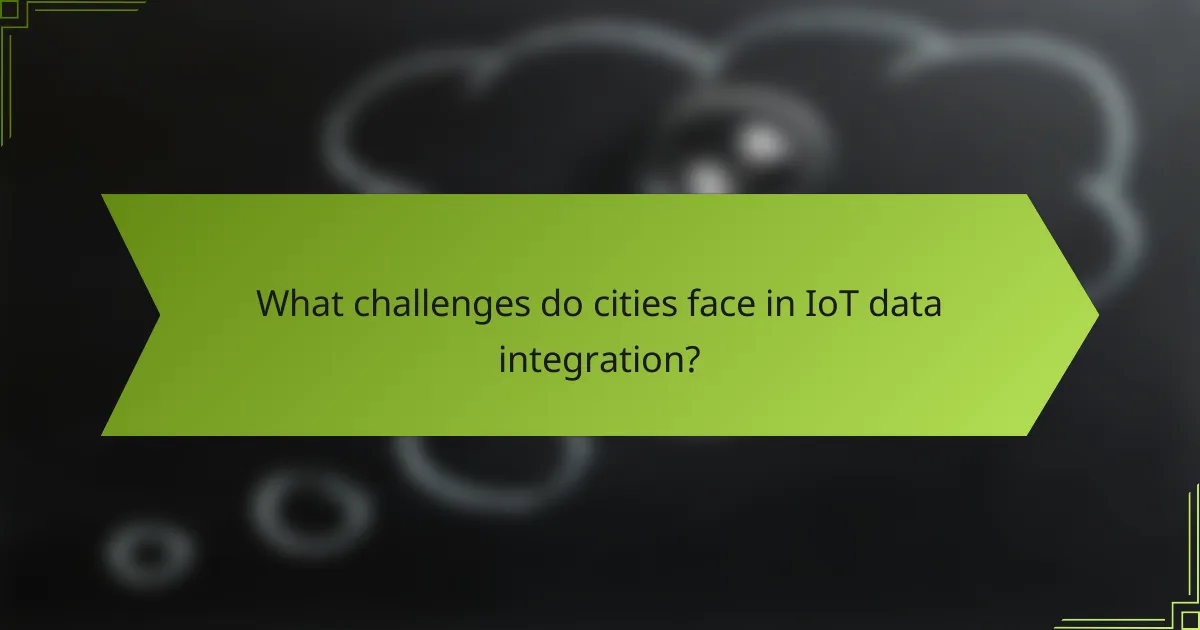
What challenges do cities face in IoT data integration?
Cities encounter several challenges in integrating IoT data, including data privacy concerns, interoperability issues, and scalability limitations. Addressing these challenges is crucial for the effective visualization of smart city dashboards.
Data privacy concerns
Data privacy is a significant challenge in IoT data integration, as cities collect vast amounts of personal information from residents. Ensuring compliance with regulations like GDPR in Europe or CCPA in California is essential to protect citizens’ privacy.
To mitigate privacy risks, cities should implement strong data encryption and anonymization techniques. Regular audits and transparency about data usage can also help build public trust.
Interoperability issues
Interoperability issues arise when different IoT devices and systems cannot communicate effectively. This lack of standardization can lead to fragmented data sources, making it difficult to create cohesive visualizations.
To enhance interoperability, cities should adopt open standards and protocols, such as MQTT or CoAP, which facilitate communication between diverse devices. Collaborating with technology providers to ensure compatibility can also streamline integration efforts.
Scalability limitations
Scalability limitations can hinder a city’s ability to manage growing volumes of IoT data. As more devices are deployed, the infrastructure must support increased data processing and storage demands.
To address scalability, cities should consider cloud-based solutions that offer flexible resources and can expand as needed. Implementing edge computing can also reduce latency and bandwidth usage by processing data closer to the source.

What criteria should cities consider for selecting IoT integration solutions?
Cities should prioritize criteria such as cost-effectiveness, ease of use, and vendor support when selecting IoT integration solutions. These factors ensure that the chosen systems are not only financially viable but also user-friendly and backed by reliable assistance.
Cost-effectiveness
Cost-effectiveness is crucial for cities operating within budget constraints. Solutions should offer a balance between initial investment and long-term operational savings, including maintenance and energy costs. Consider options that provide clear return on investment (ROI) projections, ideally within a few years.
When evaluating costs, look for scalable solutions that can grow with the city’s needs. This flexibility can prevent future expenses related to system upgrades or replacements. Comparing total cost of ownership (TCO) across different vendors can also help identify the most economical choice.
Ease of use
Ease of use is essential for ensuring that city staff can effectively manage and operate IoT systems. Solutions should feature intuitive interfaces and require minimal training for users. This reduces the time and resources needed for onboarding personnel.
Consider platforms that integrate seamlessly with existing city systems, allowing for a smoother transition and better data management. User feedback and reviews can provide insights into the usability of different solutions, helping cities make informed decisions.
Vendor support
Reliable vendor support is vital for maintaining IoT systems and addressing any issues that arise. Cities should assess the level of technical support offered, including response times and availability of resources. A vendor with a strong support network can significantly reduce downtime and operational disruptions.
Additionally, consider vendors that provide ongoing training and updates to keep the system current with technological advancements. Establishing a good relationship with the vendor can also lead to better service and potential discounts for future upgrades or expansions.
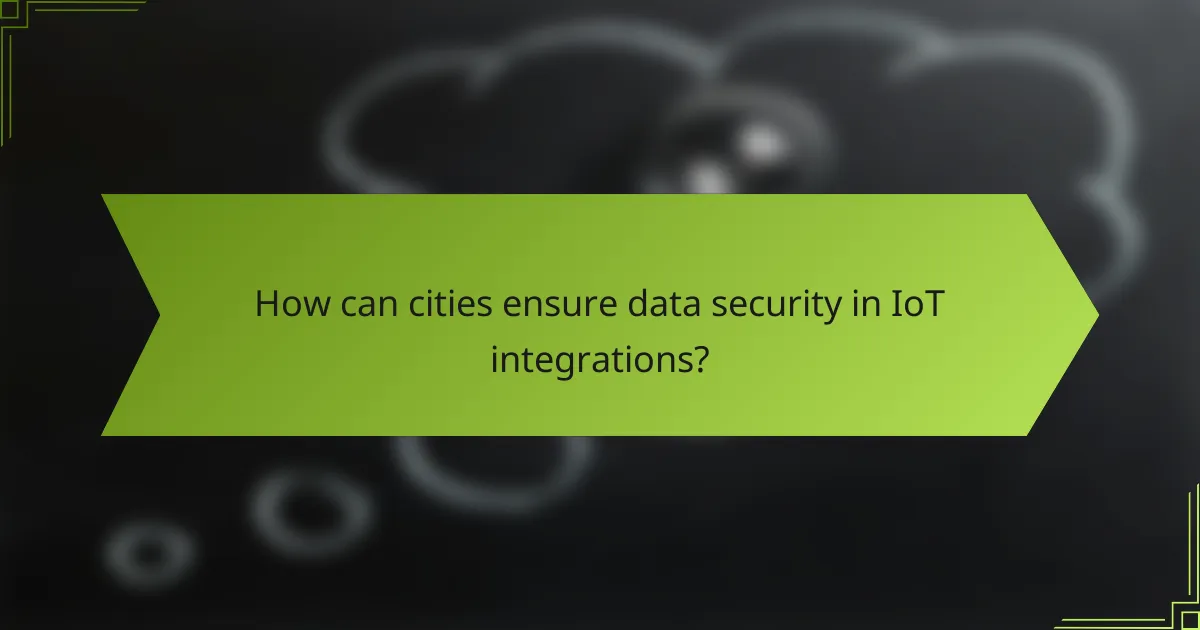
How can cities ensure data security in IoT integrations?
To ensure data security in IoT integrations, cities must adopt a multi-layered approach that includes robust encryption, regular security assessments, and adherence to best practices. These strategies help protect sensitive information and maintain public trust in smart city initiatives.
Implementing encryption protocols
Encryption protocols are essential for safeguarding data transmitted between IoT devices and centralized systems. Cities should implement strong encryption standards, such as AES (Advanced Encryption Standard) with a key length of at least 256 bits, to protect data both in transit and at rest.
Additionally, using secure communication protocols like TLS (Transport Layer Security) can help prevent unauthorized access during data exchange. Regularly updating encryption methods and protocols is crucial to counter evolving security threats.
Regular security audits
Conducting regular security audits is vital for identifying vulnerabilities in IoT systems. Cities should schedule these audits at least annually, involving third-party security experts to ensure an unbiased assessment of their infrastructure.
During audits, cities should evaluate the effectiveness of their encryption protocols, access controls, and incident response plans. This proactive approach helps cities address potential weaknesses before they can be exploited, ensuring a more secure smart city environment.
